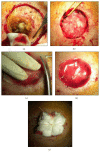One-Stage Reconstruction of Scalp after Full-Thickness Oncologic Defects Using a Dermal Regeneration Template (Integra)
- PMID: 26649312
- PMCID: PMC4663323
- DOI: 10.1155/2015/698385
One-Stage Reconstruction of Scalp after Full-Thickness Oncologic Defects Using a Dermal Regeneration Template (Integra)
Abstract
The use of Dermal Regeneration Template (DRT) can be a valid alternative for scalp reconstruction, especially in elderly patients where a rapid procedure with an acceptable aesthetic and reliable functional outcome is required. We reviewed the surgical outcome of 20 patients, 14 (70%) males and 6 (30%) females, who underwent application of DRT for scalp reconstruction for small defects (group A: mean defect size of 12.51 cm(2)) and for large defects (group B: mean defect size of 28.7 cm(2)) after wide excision of scalp neoplasm (basal cell carcinoma and squamous cell carcinoma). In group A, the excisions were performed to the galeal layer avoiding pericranium, and in group B the excisions were performed including pericranium layer with subsequent coverage of the exposed bone with local pericranial flap. In both the groups (A and B) after the excision of the tumor, the wound bed was covered with Dermal Regeneration Template. In 3 weeks we observed the complete healing of the wound bed by secondary intention with acceptable cosmetic results and stable scars. Scalp reconstruction using a DRT is a valid coverage technique for minor and major scalp defects and it can be conducted with good results in elderly patients with multiple comorbidities.
Figures









References
-
- Murtagh J. The rotation flap. Australian Family Physician. 2001;30(10, article 973) - PubMed
MeSH terms
Substances
LinkOut - more resources
Full Text Sources
Other Literature Sources
Medical
Miscellaneous

